This post was sponsored by Similarweb. The opinions expressed in this article are the sponsor’s own.
According to Rand Fishkin:
‘For most small and medium businesses and newer creators/publishers, SEO is likely to show poor results until you’ve established credibility, navigational demand, and a strong reputation among a sizable audience.’
In other words, if you want to build organic traffic, build your brand.
The question is how do search engines measure brand, and what does that mean to your SEO?
In this post, I’ll dig into what influence SEOs have over brand-building, and show you:
- Why branded SEO is an untapped opportunity you should grab with both hands.
- How brand in SEO differs from traditional brand strategy.
- Ways you can educate Google about your brand.
Branded SEO, An Untapped Opportunity
Branded SEO remains a largely untapped SEO opportunity. It’s untapped because, as SEOs, we’re trained to ignore branded traffic. However, by ignoring branded search, you are potentially missing some big opportunities to move your business forward.
The reason is that users don’t just use search engines to discover information and products. They also use search engines to discover brands. By focusing on how your brand shows up, you have an opportunity to influence how middle-of-the-funnel users perceive your brand. If you get it right, that could turn into a long-term relationship with your brand. Get it wrong, and I’m sure you have a number of competitors that would love to have the business.
This leads us to a crucial question…
Is There An SEO Angle To Brand?
As SEOs, we influence how content appears on search engines. The function of a search engine is to match end users with content. This means as SEOs, we are not just dealing with how users perceive your brand. We are dealing with how search engines understand how users perceive your brand.
The difference is not subtle.
Search engine algorithms measure how strong a brand is and incorporate those signals into the search results. They primarily seem to use three methods:
- Measuring branded search queries
- Measuring brand engagement metrics
- Understanding your brand entity
So, if the search engine incorporates brand signals into how it generates search results, then as SEOs we should be looking for a strategic way to influence these signals.
1. Branded Search Queries
Google’s leaked documents reveal a crucial aspect of branded SEO: the strength of a brand significantly influences its search rankings. This is measured through what we can call the BrandQueryFactor. This metric assesses how frequently users search for a brand by name. The more brand-specific queries a company receives, the higher its likelihood of ranking well in search results.
We understand that branded searches affect your rankings, the question now is, in what way do they affect your rankings?
Perhaps the answer can be found in a Google patent called Ranking Search Results. This patent describes how Google uses branded search queries as a quality factor similar to links. In fact, it describes branded and navigational queries as implied links that demonstrate user trust and intent.
These ‘implied links’ have a slightly different role in establishing a site’s authority than actual links:
- Links act as a vote of confidence from other websites, often indicating external recognition or authority
- Branded queries reflect real-world user interest, signaling how often users search for and interact with a resource through queries
Putting that together with the Google leak metrics above, we see that brand signals include user engagement and branded query analysis. Google uses these signals to see how users engage with your brand.
Increasing brand signals with branded queries and direct traffic
As an SEO can you increase branded traffic? The sad truth is, not directly. When your SEO starts to bring in traffic you will see an increase in branded searches. But this is an indirect benefit rather than a branded search strategy.
Does this mean branded search is out of your hands?
To answer this, it’s important to first understand how to increase brand signals.
A few years ago, when I worked as an SEO manager, I noticed something. Whenever we ran PPC campaigns, we would see increasing amounts of branded search terms in our Search Console accounts.
The reason is pretty simple. People saw our ads and Googled the brand name. Take a look at the Similarweb Channels report below. What do you see? (Hint, the blue line represents organic traffic.)
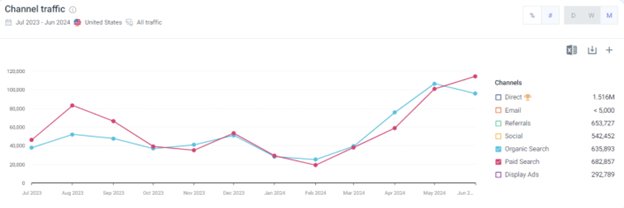 Screenshot from Similarweb, September 2024
Screenshot from Similarweb, September 2024Channel data for greenies.com
As we see above, organic traffic seems to correlate directly with paid search.
 Screenshot from Similarweb, September 2024
Screenshot from Similarweb, September 2024Looking at the organic search breakdown for the brand in 2023, we see that 72% of the site’s keywords were branded.
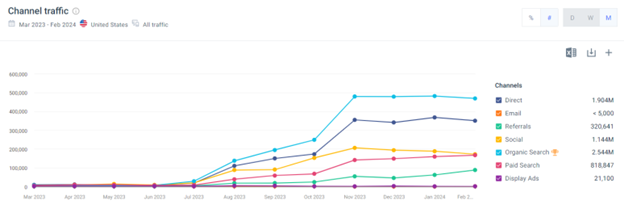 Screenshot from Similarweb, September 2024
Screenshot from Similarweb, September 2024
Channel data for elorea.com
What we see above is organic traffic directly correlates with other channels.
 Screenshot from Similarweb, September 2024
Screenshot from Similarweb, September 2024Looking at the organic search breakdown for the brand in 2023, we see that 81% of the site’s keywords were branded.
The reason for this pattern is that the more your audience sees your brand, the more likely they are to Google your brand.
Another great example of this is monday.com. The brand has doubled down on its brand strategy, focusing primarily on YouTube ads.
 Screenshot from Similarweb, September 2024
Screenshot from Similarweb, September 2024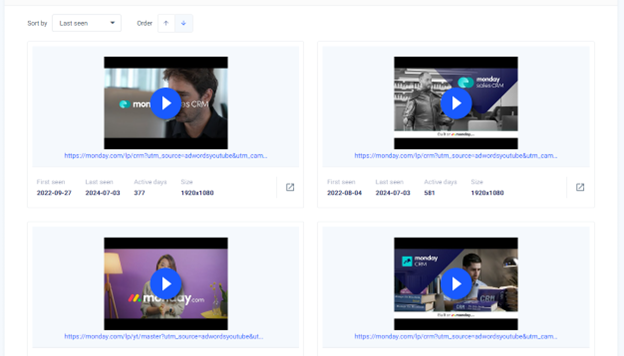
Its YouTube ads together with its memorable domain name has led to unprecedented levels of direct traffic.
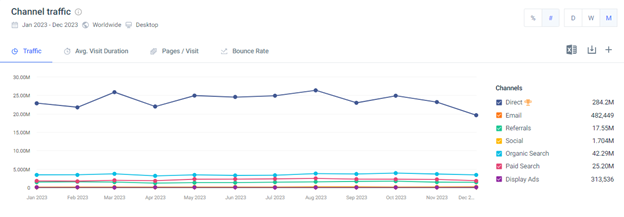 Screenshot from Similarweb, September 2024
Screenshot from Similarweb, September 2024Although I haven’t yet seen evidence that Google uses direct traffic as a ranking signal, it stands to reason that it does. What’s more, you can see that Google has taken notice of the brand.
Try Googling the word Monday and then Google the word Tuesday and compare the results. To Google the word Monday refers to a brand.
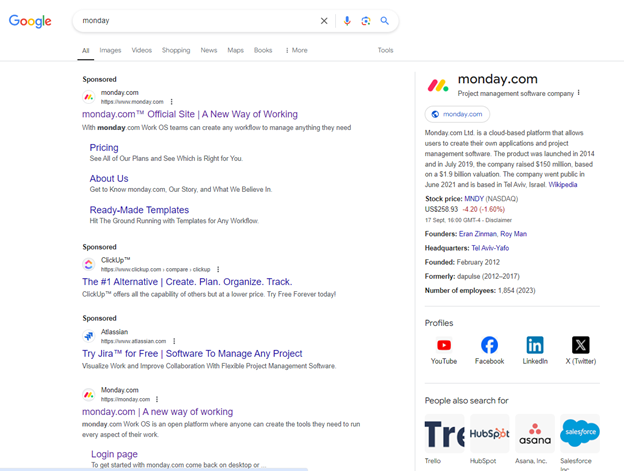 Screenshot from search for Monday, Google, September 2024
Screenshot from search for Monday, Google, September 2024
Tuesday, on the other hand, is a day of the week.
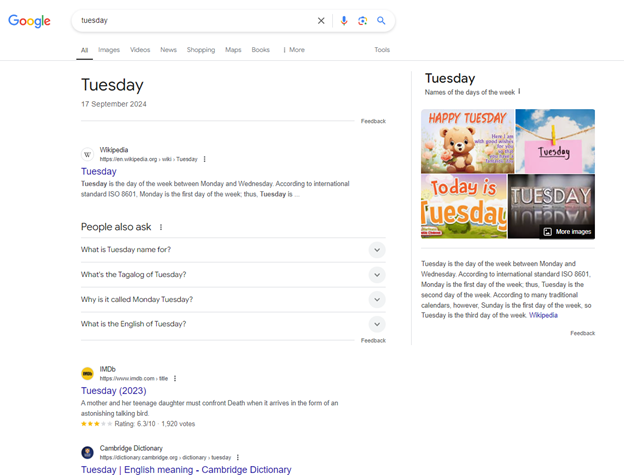 Screenshot from search for Tuesday, Google, September 2024
Screenshot from search for Tuesday, Google, September 2024The takeaway: You can increase brand signals like branded keywords and direct traffic by focusing on other channels.
So where does this leave you as an SEO?
You have the data to assess branded keywords and direct traffic, putting you in a unique position to partner with marketing leaders to work on big-picture marketing strategies designed to increase branded keywords.
2. Brand Engagement Metrics
Looking at the Google leak we can also see that Google measures user engagement as a signal of brand strength.
Brand Engagement Metrics includes user engagement factors such as click-through rates (CTR) and user interactions with the brand’s content. Higher engagement can positively influence rankings.
This means focusing on improving user engagement is a crucial aspect of brand SEO.
The best way to evaluate user engagement on your site is to compare your engagement metrics with that of your competitors.
For instance I’m analyzing toyota.com and four of its competitors with the Similarweb Website Performance report. Looking at the Engagement metrics we see that ford.com is getting more engagement in almost all metrics.
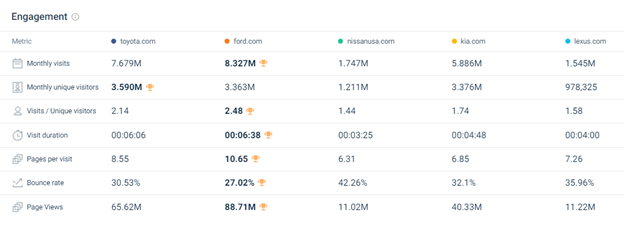 Screenshot from Similarweb, September 2024
Screenshot from Similarweb, September 2024One of the best ways to improve user engagement is to focus on site navigation. This means figuring out the flow of information on your site and including it in your:
- URL structure
- Bread crumbs
- Top level menu
Also make sure that the top of the fold section of every piece of content directly answers the user intent directly.
3. Creating content For [Brand] + Modifier Keywords
You have direct influence over how your brand appears when users search for it on Google. While you might assume all your branded traffic goes to your homepage, there are actually other ways to capture this traffic.
What’s more, your branded traffic can help you discover customer sticking points or even areas where you are potentially losing customers to your competitors.
Want to see how? Try digging through your branded keywords. You are looking for keyword modifiers that either represent issues to resolve or opportunities to be won.
Keyword modifiers might be:
- [brand] pricing
- [brand] reviews
- [brand] alternative
- Where is [brand] located
- [brand] alternative
By looking through your branded keywords, you can quickly see how users are interacting with your brand by seeing the questions they are asking. Make sure you have content that answers all of these questions. If you find long-tail queries it might be a good idea to create an FAQ on your site.
If you don’t do this you might see your branded traffic go to sites like YouTube or worse, your competitors.
For instance using the Similarweb SERP Players report below, we see a large portion of branded clicks for Ninja Creamy going to YouTube.
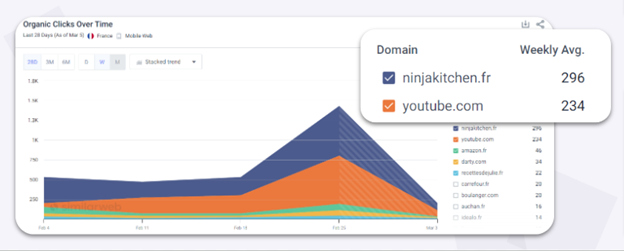 Screenshot from Similarweb, September 2024
Screenshot from Similarweb, September 2024What’s fascinating about this is that YouTube is not above the fold. This means that users often have more than one search intent and are willing to scroll to find what they are looking for. Can you afford to lose traffic for YouTube?
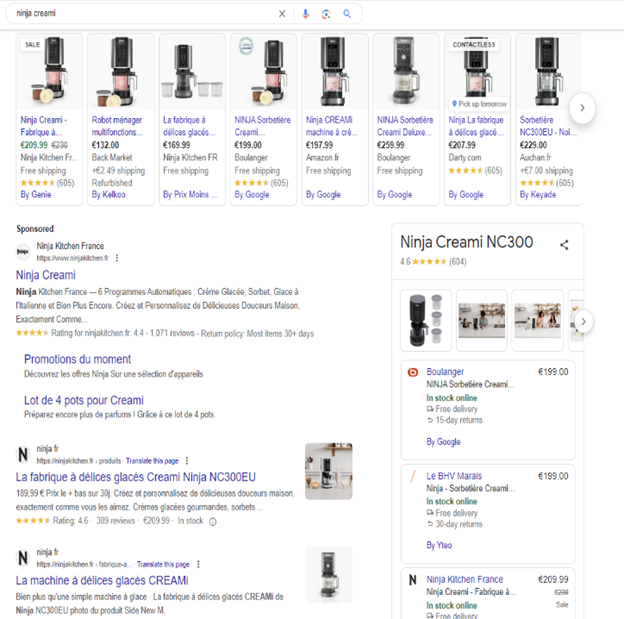 Screenshot from search for Ninja Creami, Google, September 2024
Screenshot from search for Ninja Creami, Google, September 2024In a case like this depending on which videos users are clicking on, it might make sense for the brand to create video content designed to feature on the SERP.
A great example of a brand that got this right is wildgrain.com. In 2023, the keyword ‘wildgrain reviews’ was trending. Fortunately for the brand they already included a page on their site featuring reviews.
Googling the keyword, users were faced with Wildgrain’s own reviews page ranking in position #1. What’s more the rich result included a review rating of 4.7 out of five. It also listed the amount of reviews (which currently stands at 31040.)
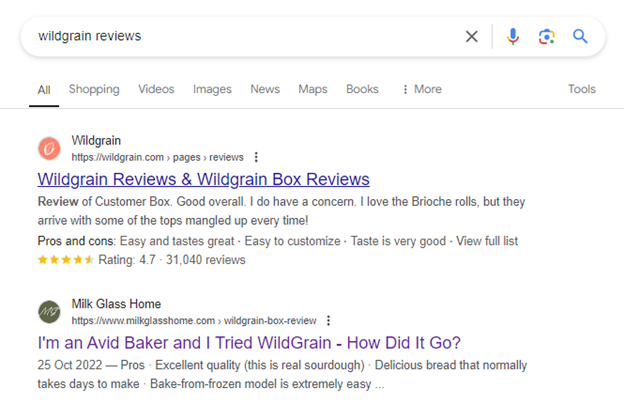 Screenshot from search for Wildgrain reviews, Google, September 2024
Screenshot from search for Wildgrain reviews, Google, September 2024Our data shows that 72% of searches were zero-click. That means the vast majority of users were satisfied with what they saw in the search results.
What’s interesting is of the remaining 28% of users, 57% clicked on the Wildgrain’s own result.
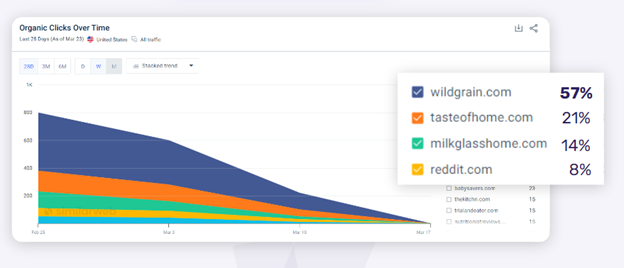 Screenshot from Similarweb, September 2024
Screenshot from Similarweb, September 2024The takeaway is with the right content, you can directly influence how users interact with your brand, even on things like reviews.
4. Educating Search Engines About Your Brand Entity
Another aspect of how Google evaluates your brand is through your brand entity. Google’s machine learning allows the search engine to understand real-world entities. It does this by gathering information about entities mentioned around the web and arranging that information in a similar way to how a human brain arranges information.
The purpose of this is to understand the relationships between people, places, and things so that Google can deliver more relevant and contextual information in the SERPs.
Google’s knowledge is constantly expanding and updating as new information becomes available.
How does Google understand your brand?
To find out, just Google it. If there are strong signals around the web, Google will present you with things like a Knowledge Panel, Twitter (X) boxes, image boxes and more.
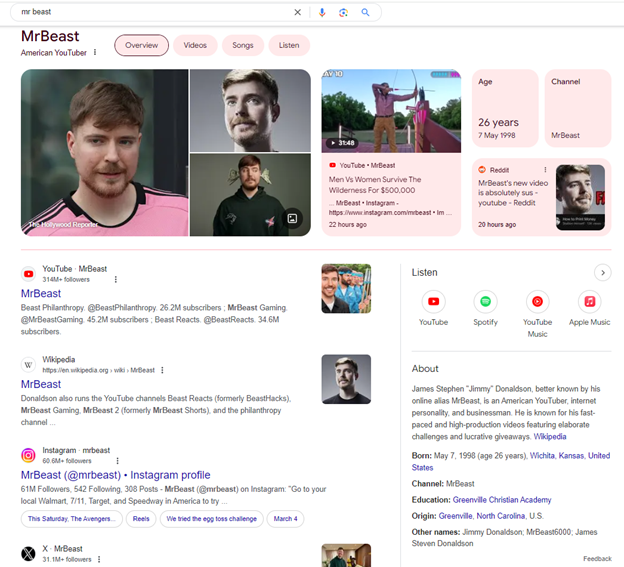 Screenshot from search for Mr Beast, Google, September 2024
Screenshot from search for Mr Beast, Google, September 2024If you don’t see anything, you have work to do, as I mentioned above, a large portion of users hear about your brand and then Google you. What they see when they arrive on your brand SERP is up to you.
The great news is you can educate Google about your brand entity. When you do that, you’ll not only improve your brand SERP, but you might see your brand popping up in other strategic places.
For instance, below, I’ve searched for Fandango, a company that sells movie tickets. If you look at the bottom of the Knowledge Panel on the right, you’ll see Fandango’s direct competitors including:
- AMC Theatres
- Regal Cinemas
- Cinemark Theatres
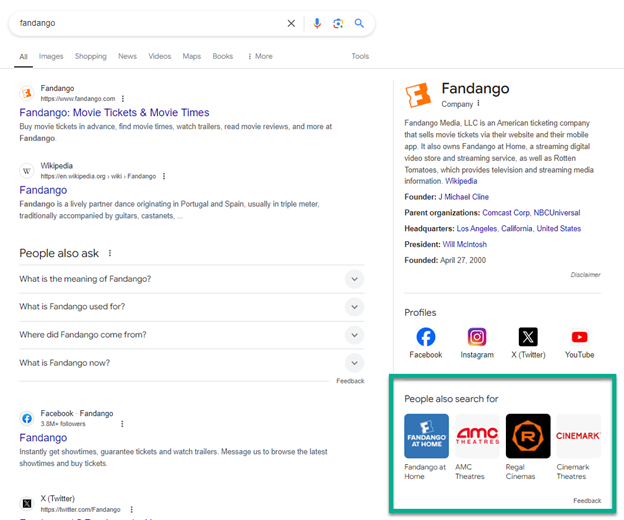 Screenshot from search for Fandango, Google, September 2024
Screenshot from search for Fandango, Google, September 2024How did a site’s competitors make it into the site’s Knowledge Panel? Google doesn’t only rank content for keywords any more. It understands what the brand entity is and what it relates to. The result is you might find your brand mentioned appearing on your competitor’s brand SERP or in other relevant places on the web.
How do you educate Google about your brand entity?
There is a clear method to educate Google about your brand entity.
- Establish an entity home page: Create a dedicated page that describes your entity. This page should clearly outline what your business does and who it serves. Although this can be any page on the web, the best place to do this is on your ‘About Us’ page.
- Build entity citations: Mentions of your brand across the web will reinforce the information provided on your brand homepage. It’s important to keep your brand description consistent around the web so that Google can match each citation with your entity’s home page. Citations can appear on pages you control, such as social media profiles but citations on pages you don’t control often carry more weight and provide the most benefit.
- Link from your entity homepage to your entity citations: This could mean including links to your social media profiles as well as any guest posts, videos, or podcasts your brand is featured on.
Far From The Final Word On Brand SEO
As an SEO, if you prioritize branded SEO, you are not just a technical specialist. You have access to data to shape the business’s digital identity, which can drive tangible and sometimes immediate results. This paradigm shift allows you to directly impact revenue streams, aligning SEO efforts more closely with overarching business objectives.
If branded SEO is a paradigm shift for you, consider this.
Branded SEO is only one ranking factor in Google’s complex maze of ranking systems. You can read more about it in our latest ebook: Google’s Ranking Anatomy: Dissecting 90+ Ranking Signals.
Image Credits
Featured Image: Image by Similarweb. Used with permission.
In-Post Image: Images by Similarweb. Used with permission.
